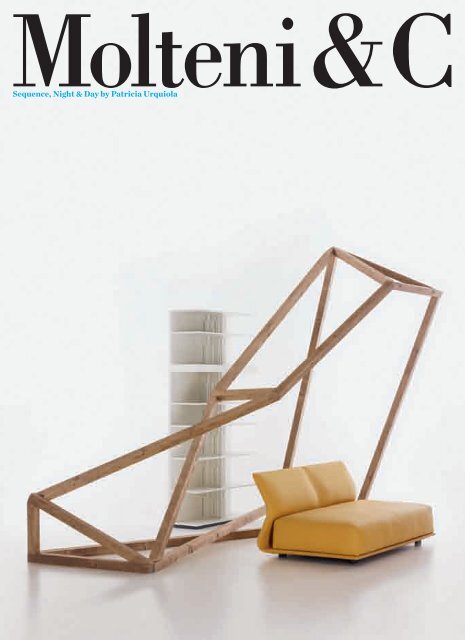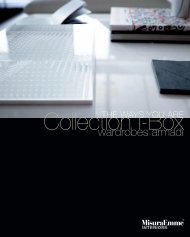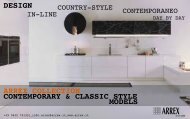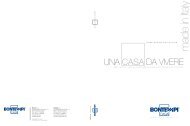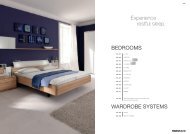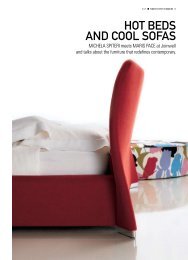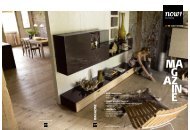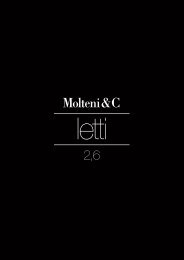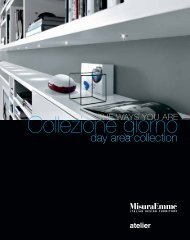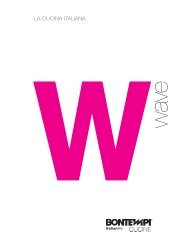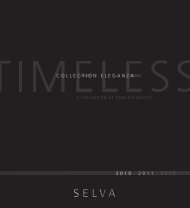Sequence, Night & Day by Patricia Urquiola - Joinwell
Sequence, Night & Day by Patricia Urquiola - Joinwell
Sequence, Night & Day by Patricia Urquiola - Joinwell
Create successful ePaper yourself
Turn your PDF publications into a flip-book with our unique Google optimized e-Paper software.
<strong>Sequence</strong>, <strong>Night</strong> & <strong>Day</strong> <strong>by</strong> <strong>Patricia</strong> <strong>Urquiola</strong><br />
1
Conversazione con <strong>Patricia</strong> <strong>Urquiola</strong>. La poetica del suo lavoro attraverso frammenti di pensieri<br />
A conversation with <strong>Patricia</strong> <strong>Urquiola</strong>. The poetry of her work seen through fragments of thoughts<br />
Lettere dall’A alla Z che mettono insieme pensieri ed emozioni. Parole in linea che raccontano storie inedite.<br />
Di progetti, design, incontri. Uno in particolare quello di <strong>Patricia</strong> <strong>Urquiola</strong> con Carlo Molteni.<br />
Per ricostruirlo, tra presente e passato, venticinque ministorie narrate dalla designer spagnola. Sua è la voce che ci<br />
accompagna in queste pagine, che come un viaggio iniziato anni fa, ci proietta nel futuro di una relazione fruttuosa.<br />
Iniziata con il letto Clip, proseguita con le sedute Glove, il tavolo Diamond e presente oggi, con il segno essenziale<br />
del divano <strong>Night</strong> & <strong>Day</strong> e la versatilità del sistema libreria <strong>Sequence</strong>. Una lettura breve, ma intensa, ci fa entrare nel<br />
pensiero sfaccettato e unico di un designer da sempre sulle tracce dei maestri del disegno industriale italiano.<br />
Introduzione<br />
The alphabet from A to Z which gathers together thoughts and emotions. Words lined up on a page that tell stories<br />
never before heard. About projects, designs, encounters. One in particular is the relationship between <strong>Patricia</strong> <strong>Urquiola</strong><br />
and Carlo Molteni. To reconstruct it, both its past and present, twenty-five mini-stories are narrated <strong>by</strong> the<br />
Spanish designer. Her voice guides us through these pages which, like a journey begun long, long ago, project us into<br />
the future of a fertile relationship. One that began with the Clip bed, followed <strong>by</strong> the Glove seats, the Diamond table<br />
and, in the present, with the essentiality of the <strong>Night</strong> & <strong>Day</strong> sofa and the versatility of the <strong>Sequence</strong> bookcase system.<br />
A short but intense read, it allows us a glimpse into the multifaceted and unique mind of a designer who has long<br />
looked to the masters of Italian industrial design for inspiration.<br />
5
a<br />
b<br />
c<br />
Affettività/ Affectivity<br />
È un legame sottile che si instaura con gli oggetti. Una linea di confine delicata. C’è,<br />
ma è tra le righe. Riguarda la sfera emotiva. Anche nel prodotto più austero può esserci<br />
affettività. Perché con gli oggetti dobbiamo convivere quotidianamente. Dove<br />
la riconosco? Nelle cose che mi porto dietro. Che traslocano con me. Una tazza, anche<br />
se ha il manico rotto, magari la tengo lo stesso. Quando è così gli oggetti hanno più<br />
vite. Durano nel tempo. Acquistano valore. Diventano vintage e finiscono nelle aste.<br />
È un tema al quale sono molto legata. È una forma di sostenibilità.<br />
A subtle bond which forms with objects. A delicate boundary. It is there, but it is<br />
between the lines. It deals with the emotive plane. Affectivity can exist even in the most<br />
austere of products. Because we must share our daily lives with objects. Where do I recognise<br />
it? In the things I keep hold of. The things that move house with me. I may keep a<br />
cup, even if it has a broken handle. Objects have many lives in this state. They are durable.<br />
They acquire value. They become vintage and end up in auctions. This is something<br />
I’m very passionate about. It is a form of sustainability.<br />
Bellezza/ Beauty<br />
È una parola di cui non bisogna avere paura, che voglio sempre affrontare. L’arte contemporanea<br />
ci ha insegnato che armonia e composizione possono essere limitative.<br />
Il rischio di cadere negli stereotipi è sempre dietro l’angolo. Per me la bellezza ha<br />
molte sfaccettature, diversi registri. Anche nel disordine può esserci bellezza. Oggi<br />
c’è uno spostamento di direzione. Si cercano nuove vie. A volte disarmoniche, crude.<br />
Si cambia da progetto a progetto: c’è la scelta del materiale, c’è l’ispirazione. E poi c’è<br />
l’etica. Quando progetto mi chiedo sempre perché lo sto facendo. Se l’oggetto ha un<br />
suo valore è possibile che abbia una sua bellezza.<br />
We must not be afraid of this word, it is something I’m eager to deal with. Contemporary<br />
art has taught us that harmony and composition can be restrictive. The risk<br />
of pigeonholing is always just around the corner. To me, beauty has many facets, different<br />
levels. Beauty can even be found in chaos. Today there is a change of direction. We<br />
are seeking out new paths. Disharmonious, crude at times. There are variations from<br />
project to project: there is the choice of materials, inspiration. And let’s not ignore ethics.<br />
When I’m designing, I always ask myself why I’m doing it. If the object has an intrinsic<br />
value, it is also possible that it has an inherent beauty.<br />
Comfort/ Comfort<br />
È un termine che amo molto, che ha uno stretto legame con gli oggetti. È un valore,<br />
come insegnava all’Università Tomàs Maldonado. Non soltanto in senso fisico, ma<br />
anche mentale. Certo c’entra anche l’ergonomia, ma a volte non è sufficiente. Il comfort<br />
può essere anche tattile e quindi più complesso. Se si prova fastidio non c’è comfort.<br />
Se un tessuto è appiccicoso non è confortevole. Tuttavia se un oggetto presenta<br />
degli errori, ma procura comfort mentale lo si perdona. Significa che produce sensazioni<br />
piacevoli, che merita il nostro affetto.<br />
This is a term I’m very fond of, one that has close ties to objects. It is a value, as<br />
Tomàs Maldonado used to say in his university lectures. Not only in a physical sense,<br />
but also in a psychological one. Obviously, ergonomics comes into it too, but at times<br />
it does not suffice. Comfort can also be tactile and, therefore, more complex. If something<br />
irritates you, it lacks comfort. If a textile is sticky, it is not comfortable. However,<br />
if an object is defective but provokes psychological comfort, then this exonerates it.<br />
This means it produces pleasurable sensations which deserve our affection.<br />
Dettaglio/ Detail<br />
È l’anima di un progetto. Non va mai sottovalutato. Se un dettaglio, che è una parte<br />
dell’oggetto, è volgare allora l’insieme non funziona. Curare il dettaglio è mettere<br />
amore nel proprio lavoro, guardare le cose da molto vicino. Mi piace arenarmi nel<br />
dettaglio. Si ottengono grandi risultati. Se non segui a sufficienza un dettaglio dopo<br />
la paghi. Quando non riesco a esprimermi nella totalità la cosa non mi interessa.<br />
Se tutte le parti, grandi e piccole, non sono curate contemporaneamente mi resta la<br />
preoccupazione.<br />
This is the soul of a project. It should never be underestimated. If a detail, which<br />
is part of an object, is vulgar then the whole will not work. Paying attention to details is<br />
to inject love into one’s work, to study things closely. I like to immerse myself in details.<br />
Excellent results can be obtained thus. If you don’t pay enough heed to a detail, you will<br />
pay later. When I am unable to totally express myself, I lose interest. If all the parts, big<br />
and small, are not dealt with simultaneously, this bothers me.<br />
Diamond/ Diamond<br />
È il dettaglio che racconta l’unicità del prodotto. Perché è il frutto dell’amore con<br />
cui si fanno le cose. E nell’amore si è in due. E’ il caso del tavolo Diamond. Io avevo<br />
l’ossessione dell’origami: del foglio piegato, dell’azione che crea la forma. Non volevo<br />
uno stampo e sapevo di avere dalla mia un’azienda di grande capacità e esperienza.<br />
Il risultato è sotto gli occhi di tutti: le gambe di Diamond sono piegate e giuntate in<br />
maniera invisibile. La qualità rende questo pezzo unico. Ringrazio Molteni&C per la<br />
riuscita.<br />
It is the detail that expresses the uniqueness of the product. Because it is the fruit<br />
of the love we apply to doing things. And it takes two for love to exist. This is the case<br />
with the Diamond table. I was obsessed with origami, with folded paper, with the action<br />
that creates the shape. I didn’t want a cookie-cutter table, and I knew I was dealing with<br />
a company of great talent and experience. The result is before our very eyes: Diamond’s<br />
legs are folded and connected in an invisible fashion. Quality makes this piece unique.<br />
I thank Molteni&C for its success.<br />
6 7<br />
Henry Bourne<br />
d
e<br />
f<br />
g<br />
Eleganza/ Elegance<br />
Il termine in sé mi irrigidisce. Mi spinge a porre paletti per non cadere negli stereotipi. Ci<br />
vuole un atteggiamento delicatamente irriverente per affrontarla. Per chiedersi cosa oggi<br />
sia elegante. Sicuramente la naturalezza è una bella forma di eleganza. Che vuole anche<br />
dire personalità, carattere, stile proprio. Senza fronzoli, senza superfluo. Se nel progettare<br />
ho dei dubbi ripenso l’oggetto in chiave di essenzialità e pulizia. Questo aiuta molto. Questo<br />
per me è eleganza.<br />
The term itself makes me tense up. It drives me to apply limits so as to avoid falling into<br />
the trap of stereotypes. A delicately irreverent approach is needed to deal with it. To ask yourself<br />
what elegance means today. Naturalness is without a doubt a wonderful form of elegance.<br />
Which also means personality, character, and a personal style. With no frills, no superfluousness.<br />
If I have any doubts when I’m designing, I consider the object in an essential, fresh key.<br />
This helps a great deal. This for me is elegance.<br />
Femminilita’/ Femininity<br />
È una bellissima parola quando la si riconduce a uno dei due emisferi del cervello umano.<br />
Perché è qualcosa che appartiene a entrambi gli individui. Usato così il termine diventa<br />
interessante. A volte ci sono progetti dove la parte femminile prende il sopravvento. Mi riferisco<br />
in particolare a quegli oggetti che nascono da un uso disinvolto della memoria. Oggetti<br />
cari, a volte un po’ borghesi, da reinterpretare con flessibilità attraverso rapidi cambi<br />
di registro. Ecco: il cambiamento e la mobilità sono attitudini tipicamente femminili. E il<br />
mondo secondo me sta andando in quella direzione. Poi comunque, a bilanciare, c’è l’emisfero<br />
maschile. È come una partita.<br />
This is a beautiful word when you trace it to one of the two hemispheres of the human<br />
brain. Because it is something that belongs to both individuals. Used in this manner, the term<br />
becomes appealing. At times, there are projects in which the feminine side reigns supreme. I'm<br />
referring, in particular, to those objects which arise from a spontaneous use of the memory.<br />
Dear objects, sometimes even bourgeois, to be reinterpreted in a flexible manner via a rapid<br />
change of tone. Change and mobility are typically feminine attributes. And I think the world<br />
is heading in that direction. And in any case, there's the masculine hemisphere to counterbalance<br />
it. It's like a match.<br />
Flessibilità/ Flexibility<br />
Ha a che vedere con la femminilità. Perché le donne sono più abituate a passare da un registro<br />
all’altro. Quando sei piccola giochi con le bambole ma, se vuoi, puoi giocare anche con le macchinine.<br />
È una predisposizione naturale. Agli uomini non è concesso. A loro le bambole sono<br />
precluse in partenza. Inoltre le donne entrano e escono dai ruoli con più naturalità. Svolgono<br />
più attività contemporaneamente. E, dalla società, questo è un fatto più accettato.<br />
It has a strong relation to femininity. Because women are more used to shifting from one<br />
register to another. When you are little you play with dolls but, if you so please, you can also play<br />
with cars. It's a natural predisposition. This is not tolerated with males. Dolls are forbidden from<br />
the outset. In addition, women enter and exit roles more naturally. They can carry out more tasks<br />
simultaneously. And, from society's point of view, this is more easily accepted.<br />
Gioco/ Play<br />
È un tema che va sempre preso in considerazione. Per me è un regalo e, insieme, un omaggio<br />
ad Achille Castiglioni. Penso alle sue lezioni. Alla Architettura con la A maiuscola e poi<br />
alla d del design: la minuscola della vita, il quotidiano. Sapeva renderlo in maniera giocosa.<br />
Nei suoi progetti, nel restyling, nel readymade. Personalmente mi piace giocare con gli<br />
oggetti della quotidianità. Poi c’è l’attitudine al divertimento, a procedere con leggerezza.<br />
Anche quando il progetto è serio si può lavorare in maniera divertita. Anche prendendosì<br />
gioco un po’ di sé.<br />
This is a theme that must always be taken into consideration. For me it is a gift and, at the<br />
same time, a tribute to Achille Castiglioni. It brings to mind his teachings. From Architecture<br />
with a capital A, and the D of design: the lower case of everyday life. He knew how to make it more<br />
playful. In his projects, his restylings, his readymades. Personally, I like to play with everyday<br />
objects. Then there's an aptitude to having fun, to approaching projects with a light heart. Even<br />
when a project is serious, you can have fun working on it. Even making fun of oneself a little.<br />
8 9
h<br />
Glocal<br />
È uno dei termini più corrispondenti ai tempi che viviamo. Noi siamo costantemente<br />
connessi e l’informazione è assolutamente globale. I progetti che disegno devono<br />
parlare una lingua internazionale. Porto Rico, Madrid, Hong Kong, Svezia, Italia,<br />
sono le destinazioni con cui mi sto più confrontando. Devo rapportarmi al globale<br />
pur avendo le mie radici. Che sono per metà spagnole e metà milanesi. Queste due<br />
realtà sono molto importanti. Nel lavoro il gioco tra globale e locale è continuo.<br />
This is one of the terms which best corresponds to the times we are living in. We<br />
are constantly connected and information is completely global. The projects I design<br />
have to speak an international language. Puerto Rico, Madrid, Hong Kond, Switzerland,<br />
Italy: these are the destinations where I am facing most of my challenges. I have to<br />
deal with globality, even though I have my own roots. In work, the global and local are<br />
constantly playing off each other.<br />
Handcraft<br />
È come linfa. Vitale per il mio lavoro. Può sembrare strano perché mi occupo di disegno<br />
industriale e di prodotti in serie. Eppure è così. Per me significa tornare alla radice<br />
delle cose, esplorare gli archivi delle aziende, interpretare in forma contemporanea<br />
la poetica del fatto a mano. È l’handcraft trasferito nel mondo industriale. Un<br />
modo per spingere la ricerca verso risultati inaspettati che riattualizzano il concetto<br />
e la memoria, anche tattile, del manufatto. Come diceva Enzo Mari: il ruolo del designer<br />
è spostare i limiti dell’azienda. Come è successo con <strong>Night</strong> & <strong>Day</strong>, il cui meccanismo<br />
dello schienale ultrasottile e flessibile è mutuato dalla catene delle biciclette.<br />
É l’esempio di come la soluzione possa trovarsi in campi esterni al design. Punto di<br />
arrivo al quale comunque tornare. È così che si progredisce.<br />
They are like lifeblood. Vital for my work. It may seem strange because I deal<br />
in industrial design and ranges of products. And yet it’s true. For me they mean returning<br />
to the roots of things, exploring the archives of companies, interpreting in a contemporary<br />
key the poetry of handmade crafts. It’s handicrafts transferred to the industrial<br />
world. A way to drive research towards unexpected results which bring the concept and<br />
the memory, even in a tactile sense, of manufactured goods right up to date. As Enzo<br />
Mari said, a designer’s task is to break the boundaries of any given company, As was the<br />
case with <strong>Night</strong> & <strong>Day</strong>: its ultrathin and flexible backrest metamorphosed from bicycle<br />
chains. This is one example of how solutions can be found in fields beyond design. A point<br />
of arrival which should be revisited again and again. This is how progress is made.<br />
Incontri/ Encounters<br />
Belli quelli tra designer e aziende. Mi ricordo, quando ero agli inizi, di Magistretti.<br />
Arrivava agli appuntamenti in bicicletta, prendeva il caffè, fumava una sigaretta e<br />
cominciava a ragionare. Era come un rituale. Quei pomeriggi passati a discutere sul<br />
progetto sono stati una delle cose più belle di quel periodo. Mi piaceva tantissimo.<br />
Oggi quando vado nelle aziende ci passo tutto il pomeriggio. Si sta lì a parlare e si<br />
improvvisa molto. Poi torno in studio e ci ripenso. Se mi togliessero questi incontri<br />
ne soffrirei. Pensa ad esempio se, anziché prodotti industriali, facessi serie limitate.<br />
Quelle conversazioni mi mancherebbero. Prendiamo il caso di Molteni&C. Sono lì<br />
che aspetto nell’ufficio tecnico con il mitico Fusi che si occupa da sempre di prodotto<br />
e poi arrivano Carlo Molteni e sua figlia Giulia. E si parla. A volte, come nelle famiglie,<br />
gli incontri diventano un po’ scontri. Anche. La trovo una cosa molto carina.<br />
Those between designers and the companies are marvellous. I remember Magistretti<br />
from the days when I was just starting out. He would turn up at meetings on his<br />
bicycle, have a coffee, smoke a cigarette and begin to put forward his case. It was like a<br />
ritual. Those afternoons spent discussing the project were one of the best things about<br />
that whole period. I loved it. Now when I visit companies, I stay there all afternoon. You<br />
stay there chatting and you improvise a great deal. Then I return to my studio and go<br />
over everything. If I no longer had these encounters, I would suffer. Just think, for example,<br />
if instead of industrial products, I made limited edition series. I would miss those<br />
conversations. Let’s take Molteni&C. as a case in point. I’m there waiting in the technical<br />
office with the legendary Fusi who has always taken care of the products, and then<br />
Carlo Molteni and his daughter Giulia arrive. And we talk. As with families, at times we<br />
clash during these encounters. Sometimes. I find this rather sweet.<br />
Intervallo/ Interval<br />
È quello che scandisce il lavoro. Lo amo molto. lo ricerco. Credo che fare molti lavori<br />
simultaneamente e a diverse scale abbia a che fare con l’intervallo. Su certi progetti,<br />
se mi specializzassi troppo, probabilmente non mi fermerei più. Fare cose diverse mi<br />
obbliga a fare degli intervalli. A mettere una cosa in mezzo ad altre. La mia testa cambia<br />
completamente scala. È molto sano. Una volta sto in cantiere e faccio architettura,<br />
un’altra volta faccio design. Ne ho bisogno.<br />
It is what sets the rhythm of your workload. I love it, I look forward to it. I think<br />
that doing lots of jobs simultaneously, and on different scales, is all down to intervals.<br />
On certain projects, if I were to specialise too much, I probably would never stop.<br />
Doing different things obliges me to take breaks. To insert one thing in the middle<br />
of other things. My head completely changes dimension. It’s very healthy. One moment<br />
I’m on a site doing architecture, another moment I’m designing. I need this.<br />
Linea/ Lines<br />
Mi viene in mente il progetto <strong>Night</strong> & <strong>Day</strong> per Molteni&C. È stato bello riprendere<br />
il tema della linea già sperimentato con il letto Clip. Ci sono oggetti che rimangono<br />
impressi per qualche cosa. Nel caso di Clip è la linea, il profilo. Passati 7 anni, in cui<br />
comunque l’avevo ben presente nella memoria, mi è venuta l’idea di rifarlo. Più mi-<br />
10 11<br />
i<br />
l
m<br />
n<br />
o<br />
nimale, più pulito. Lavorando sul suo DNA. Perché - mi sono detta - non ripensare un<br />
oggetto nato felice rispettandolo ma, anche, giocandoci? Col tempo il punto di vista<br />
cambia. Così è nato <strong>Night</strong> & <strong>Day</strong>. Dalla revisione di una linea che ha segnato il mio<br />
rapporto con l’azienda. Sotto questo aspetto è stato un progetto molto importante.<br />
The <strong>Night</strong> & <strong>Day</strong> project for Molteni&C. springs to mind. It was nice to revisit<br />
the thesis of the line we had already experimented with the Clip bed. There are objects<br />
which make an impression for a very good reason. In the case of Clip, it was its lines, its<br />
profile. After seven years, during which time it never strayed far from my mind, I got the<br />
idea to reprise it. More clean-cut, more minimal. Working on its DNA. I asked myself,<br />
“Why not reprise an object which had a happy lifespan, respecting it but also playing<br />
with it?” With time, a viewpoint changes. That’s how <strong>Night</strong> & <strong>Day</strong> came about. From<br />
the revision of a line that was a turning point in my relationship with the company.<br />
From this perspective, it was a very important project.<br />
Multitask/ Multitasking<br />
È un’espressione della contemporaneità e dei suoi molti registri. Nella vita e nel lavoro.<br />
Il mio è multitasking, come la mia formazione, che devo a maestri come Castiglioni,<br />
Magistretti, Ponti, Sottsass. Loro si che erano multitasking: molto serenamente<br />
hanno fatto non una sola cosa ma tante e tutte insieme. Certo oggi tutto è più veloce,<br />
le comunicazioni si intrecciano e sovrappongono a grande velocità. Ciò può creare<br />
delle difficoltà ma vanno comunque affrontate. E questo a me interessa. Fa parte del<br />
mio stile di vita flessibile. Del portare avanti nello stesso tempo una famiglia e un’attività.<br />
Ed è bello tradurlo anche negli oggetti. L’importante è essere credibili pur essendo<br />
multitask.<br />
It is an expression of modernity and its many facets. In both life and work. Mine<br />
is made up of multitasking, like my training, which I owe to masters such as Albini, Castiglioni,<br />
Magistretti Sottsass. They were multitasking experts: they calmly did not one<br />
thing but many things and all at the same time. Of course, today everything is faster,<br />
communication is interwoven and overlapped at great speed. This can create difficulties<br />
which, however, must be faced. And this is what interests me. This is what makes up<br />
part of my flexible lifestyle. Of nurturing both a family and a company at the same time.<br />
And it is good to adapt it when it comes to objects too. What counts is to be credible, even<br />
when multitasking.<br />
Natura/ Nature<br />
Mi viene in mente la parola DNA, riferita sia alle persone, ma anche alle aziende. Non<br />
si può snaturare. E’ qualcosa con cui bisogna fare i conti quando si entra in relazione<br />
con qualcuno o qualcosa. Nel DNA di Molteni&C c’è l’essenzialità. Per lavorare con<br />
loro bisogna rispettarla. E’ nella loro tradizione. Si rifà alle collaborazioni con Luca<br />
Meda, ma anche alla bellissima collaborazione con gli Scarpa. E’ la loro energia e non<br />
va sprecata.<br />
The word DNA springs to my mind, in reference to both people and companies. It<br />
cannot be altered. You have to deal with it when you form a relationship with someone<br />
or something, Essentiality is in Molteni&C.’s DNA. And you have to respect this if you<br />
work with them. It’s part of their tradition. And it gets renewed in their work with Luca<br />
Meda, as well as the wonderful collaboration with the Scarpas. It is their energy and<br />
should not be wasted.<br />
Ordine/ Order<br />
È qualcosa che vedo sempre in relazione al disordine. Un concetto bellissimo, che<br />
va rapportato a un punto di vista e a un progetto. È come mettere insieme rigore e<br />
libertà. È il caso di <strong>Sequence</strong> e <strong>Night</strong> & <strong>Day</strong>. Basta pensare ai divisori della libreria,<br />
posizionabili in maniera regolare o casuale o alle sedute combinabili in infinite configurazioni.<br />
Poi ci sono gli accessori che incrementano il livello di variabilità: i cesti, i<br />
tavolini, i cuscini, le luci per la lettura. Lasciano spazio tanto all’ordine convenzionale<br />
quanto al caos personale. Che è poi una diversa forma di ordine. Le combinazioni<br />
sono totalmente libere. Ciascuno può progettare la propria. Sempre diversa.<br />
This is something I always see in relation to disorder. A beautiful concept, which<br />
needs to be interrelated to a point of view and a project. It’s like putting together rigour<br />
and liberty. This is the case with <strong>Sequence</strong> and <strong>Night</strong> & <strong>Day</strong>. Just consider the bookshelf<br />
dividers, which can be positioned either in a regular or casual fashion, or the seating arrangements<br />
which can be configured in an infinite number of combinations. Then there<br />
are the accessories that increase the variability: the baskets, the tables, the cushions,<br />
the reading lights. They leave just as much space for conventional order as for personal<br />
chaos. Which is, if you think about it, a different form of order. You have absolute freedom<br />
in the combinations. Everyone can plan their own. No two are the same.<br />
Processo/ Process<br />
Per me è come un’energia, un flusso che parte dalla concezione e arriva alla realizzazione.<br />
È necessario che però non ci siano sprechi. In una parola: energy saving. È<br />
l’unico tema veramente importante. Che vuol dire valorizzazione e ottimizzazione.<br />
A partire dalle risorse e dalle tecnologie delle aziende. Bisogna controllare il processo<br />
fino alla distribuzione. Ideazione e prototipazione fanno parte di una catena. Arrivare<br />
a commercializzare un prodotto valido vuol dire preoccuparsi anche del packaging<br />
e del trasporto. Energy saving è una forma di amore. Nel futuro è l’unica strada<br />
che vedo.<br />
This for me is like an energy, a stream that starts from its conception and ends<br />
at its creation. There must be no waste, though. In two words: energy saving. This is the<br />
only truly important subject. It means adding value and optimising. Starting from the<br />
resources and the technology in the company. The whole process, right up to distribution,<br />
has to be controlled. Coming up with ideas and creating prototypes are part of a<br />
chain. Arriving at the point of marketing a valid product means also taking care of the<br />
packaging and the transport. Energy saving is a form of love. It is the only path I see for<br />
the future.<br />
Qualità/ Quality<br />
A volte si fa confusione tra la parola lusso e la parola qualità. Prendiamo le aziende<br />
italiane. Che hanno costruito intorno al prodotto industriale un particolare mercato<br />
di nicchia. C’è grande cura: dalla realizzazione alla commercializzazione nel mondo.<br />
Questo rende un certo Made in Italy esclusivo. Ma non per il lusso quanto per la qualità.<br />
Che può essere anche nascosta: i sofisticati binari della libreria <strong>Sequence</strong> sono<br />
praticamente invisibili. Poi ci sono le qualità dei processi produttivi: l’ottimizzazione<br />
del know how e il risparmio delle energie. Questa è qualità.<br />
At times, people confuse the words luxury and quality. Let’s consider Italian<br />
companies, those which have created a niche market for industrial products. Great care<br />
is taken, from the creation to the marketing of the product. This bestows exclusivity<br />
onto certain Italian-made products. Not for their luxuriousness, but for their quality,<br />
which can even be hidden: the sophisticated sliding rail system of the <strong>Sequence</strong> bookshelf<br />
is practically invisible. Then there is the quality of the production process: making<br />
the most of our know-how, energy saving. This is quality.<br />
Re-use<br />
È l’idea di utilizzare comunque gli oggetti. Mi piace pensare che le cose acquistate entrano<br />
a fare parte della nostra vita e che quando passano in altre mani possono essere<br />
riutilizzate. Ci credo davvero. È il motivo per cui la qualità degli oggetti è importante:<br />
il modo in cui sono pensati e come sono fatti. Credo molto nel concetto di vintage.<br />
Nel valore dato dal tempo. Un oggetto immesso nel mercato può durare grazie al<br />
segno riuscito o alla qualità dei materiali. Nel caso del segno, dell’impronta, bisogna<br />
12 13<br />
p<br />
q<br />
r
evitare che diventi stucchevole. Che ci stanchi. È l’affettività la qualità che fa durare<br />
gli oggetti. Quando capita è un grande onore.<br />
It is the idea of using objects again in any manner. I like to think that the objects<br />
we buy become a part of our lives, and that if they fall into the hands of others, they can<br />
be re-used. I really do believe this. This is why the quality of objects is important: the way<br />
they are designed and then manufactured. I really believe in the concept of vintage. Of<br />
value being acquired over time. An object placed on the market can last thanks to a successful<br />
design or top quality materials. In the case of its design, the impression it leaves,<br />
it must try to avoid becoming boring. Something that turns us off. Affectivity is the quality<br />
that bestows a long life on objects. And when this happens, it’s a great honour.<br />
Sistema/ System<br />
È un tema che ho affrontato meno. Mi è capitato di pensare ai sistemi come famiglie<br />
di oggetti. Ma non fa proprio parte del mio lavoro. Un po’ si può citare <strong>Sequence</strong>,<br />
però si tratta di un prodotto che in sé è finito. Cioè non da l’idea, come pezzo matrice,<br />
dell’infinito. Tu in fondo scegli la tua libreria, poi puoi variare tantissime cose, però<br />
è comunque un progetto finito. Pensato finito. Oggi l’aspetto commerciale è molto<br />
importante. Più che anni fa. Pensa ai sistemi degli anni ’70 con le loro soluzioni praticamente<br />
infinite. Commercialmente erano prodotti molto difficili da gestire. Lo so<br />
perché ci sono cresciuta con quei progetti. Erano meravigliosi e rigorosi insieme. Li<br />
ho amati molto. Oggi la flessibilità può essere all’interno di un progetto finito. E quindi<br />
più facile da controllare. <strong>Sequence</strong> è un oggetto molto minimale, essenziale, che ha<br />
comunque le sue variabili interne che lo rendono sempre diverso.<br />
This is a subject that I have tackled less. I have sometimes thought of systems as<br />
families of objects. But this really isn’t part of my work. We could, to some extent, mention<br />
<strong>Sequence</strong>, although in itself it is a finite product. It doesn’t give the idea, as a piece<br />
of a matrix, of being infinite. At the end of the day, you choose your bookcase, then you<br />
can vary many aspects, but it remains a finite project. Planned as a finished object. Today,<br />
the commercial aspect is of vital importance. Much more so than in the past. Just<br />
think of the systems from the 1970s, with their almost infinite number of solutions. They<br />
were very difficult to market. I know, because I grew up with such projects. They were<br />
both marvellous and meticulous. I adored them. Today a finished product can be flexible.<br />
And, therefore, easier to control. <strong>Sequence</strong> is a very minimal, essential object, one<br />
which still has internal variants which make each piece unique.<br />
Tessuto/ Fabric<br />
Appartengo alla scuola di pensiero per cui se un prodotto ha una pelle in tessuto, che<br />
quindi è un materiale che va cucito, quella pelle va progettata. Ho sempre trovato limitativo<br />
lasciare che il tessuto segua morbidamente, quasi casualmente, l’oggetto. È<br />
qualcosa che va studiato, che può aggiungere qualità e identità al progetto. Questo è<br />
il primo aspetto. Poi ci sono il pattern e la decorazione. Sono molto interessata alle<br />
trame e agli orditi. Ma è qualcosa che va anche oltre il tessuto. Può essere riferito ad<br />
esempio ad un lavoro di ceramica. Come i bassorilievi. Anche <strong>Sequence</strong> in fondo presenta<br />
un lavoro sulla texture.<br />
I belong to the school of thought which believes that if a product has a fabric<br />
skin, a material which needs to be sewn, that skin needs to be designed. I have always<br />
found it to be limiting to allow the fabric to simply follow the object, almost casually. It<br />
needs to be studied, so it can add quality and identity to the project. This is the first aspect.<br />
Then the pattern and decoration have to be taken into consideration. I have always<br />
been fascinated <strong>by</strong> weft and warp. But it goes beyond fabric. It can also, for example,<br />
refer to ceramics. Like with bas-reliefs. You can see how much work on texture went into<br />
producing <strong>Sequence</strong>.<br />
Understatement<br />
È il mio credo. L’ho imparato da Magistretti. Mi ha insegnato a relazionarmi alle persone<br />
e a lavorare semplificando le cose. Senza mai ostentare. Era un uomo elegantissimo<br />
Magistretti. Portava giacche di tweed e indossava calzini rossi, poi però andava<br />
in giro per Milano in bicicletta e metropolitana. Viveva in maniera sostenibile: progettava<br />
con il minimo indispensabile senza mai sprecare energie. Sono esempi che ti<br />
formano. Poi ciascuno ha la propria educazione. Io ad esempio devo molto alla mia<br />
famiglia. Gli spagnoli hanno la propensione a rifiutare le sovrastrutture e a mostrarsi<br />
per quello che sono. È una forma di understatement. Si vive meglio, si sta meglio, ci si<br />
esprime meglio. Anche decidere di fare design è una scelta understatement. Lo dico<br />
14 15<br />
s<br />
t<br />
u
16<br />
v<br />
z<br />
sempre. Un designer può lavorare con niente e avere un micro studio. Nell’architettura,<br />
che amo moltissimo e mi piace tantissimo fare, è diverso.<br />
This is one of my beliefs. I learnt it from Magistretti, who taught me to relate<br />
to people and to always simplify things while working. Without ever being showy. He<br />
was a very elegant man. He’d wear tweed jackets and red socks, and he’d travel around<br />
Milan on his bicycle and on the metro. He led a sustainable life: he’d design with the bare<br />
essentials, without ever wasting energy. These sorts of examples are edifying. Then<br />
each person had the upbringing that they had. I, for example, owe a great deal to my<br />
family. Spanish people tend to refuse too many trappings, they prefer to be seen for what<br />
they are. This is a form of understatement. You live better, you feel better, you express<br />
yourself better. Merely deciding to be a designer is an understated choice. That’s what<br />
I always say. A designer can work with nothing and have a tiny studio. In architecture,<br />
which I adore practising, the situation is very different.<br />
Vuoto/ Void<br />
Amo il vuoto. Come l’intervallo. È qualcosa su cui si può lavorare in maniera interessante.<br />
Senza bisogno di riempirlo per forza. Penso allo spazio cavo della gamba del<br />
tavolo Diamond. Ha una sua dignità, una sua forza. Ha carattere. Esprime bene il mio<br />
lavoro per la Molteni&C. Che si fonda sull’essenzialità. È una linea di pensiero che<br />
caratterizza il mio rapporto con loro. L’azienda mi spinge in questa direzione. Si vede<br />
molto nei progetti. Hanno un rigore che appartiene al loro DNA. Per questo era importante<br />
che la gamba del tavolo non fosse riempita. Colmare il vuoto è un’azione da<br />
ponderare attentamente. Il vuoto ha un suo valore. Come il silenzio o le poche parole,<br />
che poi sono nella natura di un uomo come Carlo Molteni. Troppo spesso la cultura<br />
occidentale ha paura del vuoto. È la ragione per cui io amo il mondo orientale.<br />
I love a void. Like an interval. It is something that can be fascinating to work on.<br />
Without the need to fi ll it. The hollow legs of the Diamond table spring to mind. They<br />
have their own dignity, their own strength. They have character. And they perfectly express<br />
my work for Molteni&C., which is based on essentiality. It’s a way of thinking that<br />
characterises my relationship with them. The company encourages me in this direction.<br />
And this is clearly visible in our projects. Perfectionism is in their blood. This is why it<br />
was important that the table legs remained hollow. Filling a void is an action that needs<br />
to be carefully pondered. A void has its own value. Like silence or few words, things that<br />
are second nature to a man like Carlo Molteni. Western cultures too often fear voids.<br />
That is why I love the Orient.<br />
Zoom<br />
È il fuoco su un dettaglio. Lo sguardo ravvicinato. E nel progetto è fondamentale.<br />
Puoi anche partire con idee e concetti fantastici se però alla fi ne certi dettagli sono<br />
stridenti è come buttare tutto. Non riuscire ad affi nare il processo di un prodotto rovina<br />
sia gli oggetti che le architetture. Un dettaglio sbagliato, o di troppo, rovina la<br />
sensazione che hai di una cosa. Poi vedi solo quello. È un errore che non perdona<br />
It’s the focus on the details. An extreme close-up. And this is fundamental in any<br />
project. You can begin with fantastic ideas and concepts but if, in the end, certain details<br />
are incompatible, it’s like having to throw the whole thing away. Not being able to<br />
perfect the process of any product ruins both the objects themselves and the architectures.<br />
A fl awed detail, or one too many, ruins the sensations you have of any given thing.<br />
It becomes the only thing you see. And it’s an error which does not forgive.
18 19
20 21
22 23
24 25
26 27
28 29
30 31
32 33
34 35
36 37
38 39
40 41
42 43
44 45
46 47
50<br />
<strong>Sequence</strong>, la nuova libreria componibile di <strong>Patricia</strong> <strong>Urquiola</strong>, è un esempio di architettura domestica che trae<br />
l’ispirazione dai moderni stili compositivi caratterizzanti molti edifici di nuova concezione. La flessibilità compositiva<br />
di <strong>Sequence</strong> permette di introdurre in ambito domestico il concetto di simmetria e asimmetria innovativo<br />
per questo tipo di prodotti. Una struttura aerea priva di spalle laterali, caratterizzata dalla presenza di un elemento<br />
a trave di forte spessore, su cui possono scorrere ante in materiali diversi come acciaio traforato in diverse<br />
finiture, essenza, superfici laccate in originali colori oppure vetro serigrafato dai motivi geometrici di grande impatto.<br />
Due tipi di divisori, semplici o traforati ad U, da posizionare in modo libero sui ripiani, per creare sequence<br />
simmetriche o asimmetriche, che facilitano il posizionamento di ogni tipo di oggetto all’interno della libreria.<br />
<strong>Sequence</strong> è un progetto d’avanguardia non solo per il disegno ma anche per la tecnologia utilizzata. Piani strutturali<br />
e divisori sono infatti rivestiti d’alluminio verniciato, per dare solidità strutturale a tutta la libreria, anche in<br />
caso di presenza di moduli di grande ampiezza. <strong>Sequence</strong> è disponibile in diverse modularità, sia in altezza sia in<br />
larghezza atte a creare diverse soluzioni di contenimento di grande impatto e rigore funzionale.<br />
<strong>Sequence</strong><br />
<strong>Sequence</strong>, <strong>Patricia</strong> <strong>Urquiola</strong>’s new modular bookcase, is an example of domestic architecture which draws its<br />
inspiration from modern composition styles featured in many contemporary buildings. <strong>Sequence</strong> is modular and<br />
therefore flexible, bringing the concept of symmetry and assymetry into the domestic setting, an innovative concept<br />
for this type of product. An airy structure without side partitions, and featuring a thick beam element along which<br />
run sliding doors in various materials such as carved steel in various finishes, essences, surfaces lacquered in original<br />
colours or glass etched with high impact geometrical designs. There are two types of partition, plain or carved in U<br />
shape, to place freely on the shelves and created symmetrical or asymmetrical sequences. This gives greater freedom<br />
in what can be placed on the bookcase.<br />
<strong>Sequence</strong> is avant-garde in both design and technology. Structural shelving and partitions are covered with lacquered<br />
aluminium to give strength and stability to the whole bookcase, even in larger compositions. <strong>Sequence</strong> is available in<br />
various compositions, differing in both height and width, so as to create various storage<br />
solutions of high impact and functional discipline.
Finiture/ Finishes<br />
Struttura, schienali, piani, spalle divisorie: laccato opaco nei colori: bianco calce, nero, ambra, rosa cipria, nocciola, nero bordo noce canaletto<br />
spalle divisorie traforate: laccato opaco nei colori: bianco calce, nero, ambra, rosa cipria, nocciola<br />
Ante laccato opaco: bianco calce, nero, ambra, rosa cipria, nocciola<br />
Ante essenza: noce canaletto<br />
Ante maglia metallica laccato opaco: bianco calce, nero, ambra, rosa cipria, nocciola<br />
Ante vetro: stopsol serigrafato nero<br />
Structure, back, shelves, partitions: matt lacquer colours: chalk white, black, amber, powder pink, hazelnut, black with american walnut edge<br />
cut work partitions: matt lacquer colours: chalk white, black, amber, powder pink, hazelnut<br />
Doors - matt lacquer colours: chalk white, black, amber, powder pink, hazelnut<br />
Doors - wood: american walnut<br />
Doors - metal mesh lacquered in the colours: chalk white, black, amber, powder pink, hazelnut<br />
Doors - glass: black serigraphed stopsol<br />
Componibilità librerie P 400 mm - 15 ¾"/ Modular items - bookcases d. 400 mm - 15 ¾"<br />
Disponibile in 5 larghezze (L 1208 - 1808 - 2408 - 2708 - 3008) e in 3 altezze (H 1412 - 2006 - 2358 per la P 400)<br />
Available in 5 widths (w. 1208 - 1808 - 2408 - 2708 - 3008) and 3 heights (h. 1412 - 2006 - 2358 for d. 400)<br />
2358 - 92 ⅞"<br />
Componibilità librerie P 530 mm - 20 ⅞"/ Modular items - bookcases d. 530 mm - 20 ⅞"<br />
Disponibile in 5 larghezze (L 1208 - 1808 - 2408 - 2708 - 3008) e in 2 altezze (H 465 e 707 per la P 530)<br />
Available in 5 widths (w. 1208 - 1808 - 2408 - 2708 - 3008) and 3 heights (h. 465 e 707 for d. 530)<br />
465<br />
18 ¼"<br />
707<br />
27 ⅞"<br />
2006 - 79"<br />
1412 - 55 ⅝"<br />
1208 - 1808 - 2408 - 2708 - 3008<br />
47 ½" - 71 ⅛" - 94 ¾" - 106 ⅝" - 118 ⅜"<br />
1208 - 1808 - 2408 - 2708 - 3008<br />
47 ½" - 71 ⅛" - 94 ¾" - 106 ⅝" - 118 ⅜"<br />
1208 - 1808 - 2408 - 2708 - 3008<br />
47 ½" - 71 ⅛" - 94 ¾" - 106 ⅝" - 118 ⅜"<br />
530<br />
20 ⅞"<br />
400<br />
82<br />
3 ¼"<br />
335<br />
13 ¼"<br />
82<br />
3 ¼"<br />
224<br />
8 ⅞"<br />
335<br />
13 ¼"<br />
15 ¾"<br />
335<br />
13 ¼"<br />
224<br />
8 ⅞"<br />
82<br />
3 ¼"<br />
18<br />
¾"<br />
224 - 335<br />
8 ⅞" - 13 ¼"<br />
spalla divisoria<br />
Sp 8 mm - ⅜"<br />
partition<br />
th. 8 mm - ¾"<br />
224 - 335<br />
8 ⅞" - 13 ¼"<br />
420<br />
290<br />
11 ⅜"<br />
16 ½"<br />
31<br />
1 ¼"<br />
spalla divisoria traforata<br />
Sp 80 mm - 3 ⅛"<br />
cut work partition<br />
th. 80 mm - 3 ⅛"<br />
vista laterale<br />
lateral view<br />
70<br />
2 ¾"<br />
420<br />
16 ½"<br />
spalle<br />
partition<br />
530<br />
20 ⅞"<br />
40<br />
1 5⁄5"<br />
31<br />
1 ¼"<br />
vista laterale<br />
lateral view<br />
70<br />
2 ¾"<br />
290<br />
11 ⅜"<br />
spalle<br />
partition<br />
400<br />
15 ¾"<br />
40<br />
1 5⁄5"<br />
Esempio di posizionamento delle spalle divisorie/ Example positioning of partitions<br />
H max 2358 - 92 ⅞"<br />
max h. 2358 - 92 ⅞"<br />
Ante scorrevoli/ Sliding doors<br />
Le composizioni sono disponibili<br />
a giorno o con ante scorrevoli.<br />
In questo caso il piano Sp 82 e il<br />
piano o i piani Sp 18 vengono<br />
predisposti con i relativi binari<br />
di scorrimento; Non è mai possibile<br />
affiancare 2 ante scorrevoli;<br />
Le ante L 1208 H 1337 non sono<br />
disponibili in laccato opaco nei<br />
colori ed in noce canaletto;<br />
Per la modularità delle ante<br />
vedere gli schemi seguenti.<br />
The compositions are available open<br />
or with sliding doors. In the latter case<br />
the 82 mm th. shelf and the 18 mm th.<br />
shelf or shelves come fitted with<br />
runners; It is not possible to put<br />
2 sliding doors next to each other;<br />
The doors w. 1208 h. 1337 are not<br />
available in matt lacquer colours and<br />
in american walnut; For door composition<br />
see the following schemes.<br />
ante superiori<br />
L 908 Sp 70 mm<br />
L 35 ¾" - Sp 2 ¾"<br />
upper doors<br />
w. 908 th. 70 mm<br />
w. 35 ¾" - th. 2 ¾"<br />
H 632<br />
H 24 ⅞"<br />
L max 750 - 29 ½"<br />
max w. 750 - 29 ½"<br />
304<br />
12"<br />
150<br />
5 ⅞"<br />
H 985<br />
H 38 ¾"<br />
L max 3008 - 118 ⅜"<br />
max w. 3008 - 118 ⅜"<br />
L max 900 - 35 ⅜"<br />
max w. 900 - 35 ⅜"<br />
ante inferiori<br />
L 908 Sp 70 mm<br />
L 35 ¾" - Sp 2 ¾"<br />
lower doors<br />
w. 908 th. 70 mm<br />
w. 35 ¾" - th. 2 ¾"<br />
H 632<br />
H 24 ⅞"<br />
H 985<br />
H 38 ¾"<br />
H 1337<br />
H 52 ⅝"<br />
150<br />
5 ⅞"<br />
304<br />
12"<br />
La griglia orizzontale per singolo vano è suddivisa a<br />
passo 150 mm con partenza 304 mm.<br />
Le spalle divisorie sono posizionabili all’interno della<br />
griglia rispettando:<br />
- larghezza max 750 mm per vani esterni;<br />
- larghezza max 900 mm per vani centrali.<br />
La regola sopra indicata vale anche per le spalle traforate.<br />
The horizontal grid for single units is divided every<br />
150 mm starting at 304 mm.<br />
The partitions can be positioned inside the grid respecting:<br />
- max width 750 mm for external units;<br />
- max width 900 mm for centre units.<br />
The above mentioned rule also applies to cut works partitions.<br />
Esempio di<br />
posizionamento<br />
spalle luminose<br />
example<br />
positioning<br />
of lighting<br />
partitions<br />
ante superiori<br />
L 1208 Sp 70 mm<br />
L 47 ½" - Sp 2 ¾"<br />
upper doors<br />
w. 1208 th. 70 mm<br />
w. 47 ½" - th. 2 ¾"<br />
H 632<br />
H 24 ⅞"<br />
H 985<br />
H 38 ¾"<br />
vani<br />
illuminabili<br />
illuminated<br />
units<br />
ante inferiori<br />
L 1208 Sp 70 mm<br />
L 47 ½" - Sp 2 ¾"<br />
lower doors<br />
w. 1208 th. 70 mm<br />
w. 47 ½" - th. 2 ¾"<br />
H 632<br />
H 24 ⅞"<br />
H 985<br />
H 38 ¾"<br />
70<br />
2 ¾"<br />
H 1337<br />
H 52 ⅝"<br />
400<br />
15 ¾"<br />
vista laterale<br />
lateral view
54<br />
<strong>Night</strong>&<strong>Day</strong>, di <strong>Patricia</strong> <strong>Urquiola</strong>, è un sistema di sedute improntato al tema della versatilità, la capacità di interpretare<br />
gli spazi proponendo soluzioni innovative. Ironia, comfort, gusto, fantasia e razionalità convivono. Le<br />
diverse soluzioni - divano importante, chaise longue o comodo letto singolo - sono tutte basate sul concetto di<br />
trasformabilità. Un progetto senza limiti: colori, dimensioni, schienali regolabili e accessori, per contenere od<br />
esporre oggetti di uso quotidiano, sono combinabili tra loro per dare libera espressione al proprio gusto e piena<br />
soddisfazione a diverse esigenze.<br />
<strong>Night</strong>&<strong>Day</strong><br />
<strong>Night</strong>&<strong>Day</strong>, is a seating system based on the theme of versatility, the interpretation of spaces through new<br />
innovative solutions. Irony, comfort, taste, imagination and rationality come together in this new design <strong>by</strong> <strong>Patricia</strong><br />
<strong>Urquiola</strong>. The various solutions -important sofa, chaise longue or comfortable single bed- are all based on the idea of<br />
transformation. A design without limits: colours, sizes, adjustable back and accessories to contain or display everyday<br />
objects can be combined together to give free expression to individual taste and satisfy individual needs.
Finiture/ Finishes<br />
Imbottito: tessuto, pelle<br />
Contenitori - struttura: maglia metallica<br />
laccato opaco nei colori: bianco calce, nero<br />
Contenitori - top laccato opaco: bianco, calce, nero;<br />
Contenitori - top essenza: noce canaletto,<br />
wengé, rovere scuro, rovere grigio<br />
Cestone: maglia metallica laccato opaco nei<br />
colori: bianco calce, nero<br />
Tavolino - struttura: laccato opaco nei colori:<br />
bianco calce, nero<br />
Tavolino - piano laccato opaco: bianco calce, nero<br />
Tavolino - piano essenza: noce canaletto,<br />
wengé, rovere scuro, rovere grigio<br />
Bisaccia: cuoio nei colori, naturale, nero,<br />
testa di moro, bianco<br />
upholstery: fabric, leather<br />
Storage units - structure: metal mesh chalk white,<br />
black matt lacquered<br />
Storage units - matt lacquered top: chalk white, black<br />
Storage units - wooden top: american walnut, wengé,<br />
dark oak, grey oak<br />
Large basket: metal mesh chalk white, black, matt lacquered<br />
Small table - structure: chalk white, black matt lacquered<br />
Small table - matt lacquered top: chalk white, black<br />
Small table - wooden top: american walnut, wengé,<br />
dark oak, grey oak<br />
Pounch: hide leather in the colours, natural, black,<br />
dark brown, white<br />
Elementi lineari/ Linear elements<br />
P 102/126 cm - 40⅛"/49⅝" H 58/77 cm - 22⅞"/30⅜"<br />
d. 102/126 cm - 40⅛"/49⅝" h. 58/77 cm - 22⅞"/30⅜"<br />
L 248 cm - 97⅝"<br />
w. 248 cm - 97⅝"<br />
L 214 cm - 84¼"<br />
w. 214 cm - 84¼"<br />
L 178 cm - 70"<br />
w. 178 cm - 70"<br />
cuscino L 214 - 84¼"<br />
cushion w. 214 - 84¼"<br />
neL248/A dx-sx<br />
neL214/A<br />
neL178/A<br />
sx<br />
cuscino intero<br />
full lenght cushion<br />
cuscino intero<br />
full lenght cushion<br />
neL214/B dx-sx<br />
neL178/B dx-sx<br />
Top contenitore<br />
storage unit top<br />
Contenitore<br />
struttura<br />
storage unit<br />
structure<br />
cuscino L 178 - 70"<br />
cushion w. 178 - 70"<br />
sx<br />
cuscino L 144 - 56¾"<br />
cushion w. 144 - 56¾"<br />
sx<br />
cuscino L 178 - 70"<br />
cushion w. 178 - 70"<br />
neL248/B<br />
cuscino L 144 - 56¾"<br />
cushion w. 144 - 56¾"<br />
neL214/C<br />
L 144 cm - 56¾"<br />
w. 144 cm - 56¾"<br />
Imbottito<br />
upholstery<br />
Bisaccia<br />
pounch<br />
Tavolino<br />
small table<br />
Cestone<br />
large basket<br />
cuscino L 178 - 70"<br />
cushion w. 178 - 70"<br />
neL248/C dx-sx<br />
neL214/D dx-sx<br />
neL144/A<br />
sx<br />
cuscino L 144 - 56¾"<br />
cushion w. 144 - 56¾"<br />
sx<br />
cuscino intero<br />
full lenght cushion<br />
Isola/ Island element<br />
Isola P 102/126 cm - 40⅛"/49⅝" H 58/77 cm - 22⅞"/30⅜"<br />
Island element d. 102/126 cm - 40⅛"/49⅝" h. 58/77 cm - 22⅞"/30⅜"<br />
L 180 cm - 70⅞"<br />
w. 180 cm - 70⅞"<br />
Chaise Longue/ Chaise Longue<br />
P 190/214 cm - 74¾"/84¼" H 58/77 cm - 22⅞"/30⅜"<br />
d. 190/214 cm - 74¾"/84¼" h. 58/77 cm - 22⅞"/30⅜"<br />
L 93 cm - 36⅝"<br />
w. 93 cm - 36⅝"<br />
Bracciolo e cuscini/ Arm and cushions<br />
Bracciolo<br />
L 33 cm - 13"<br />
P 72 cm - 28⅜"<br />
H 38 cm - 15"<br />
Arm<br />
w. 33 cm - 13"<br />
d. 72 cm - 28⅜"<br />
h. 38 cm - 15"<br />
Accessori/ Accessories<br />
Contenitore<br />
L 68 cm - 26¾"<br />
P 29 cm - 11⅜"<br />
H 25 cm - 9⅞"<br />
Storage unit<br />
w. 68 cm - 26¾"<br />
d. 29 cm - 11⅜"<br />
h. 25 cm - 9⅞"<br />
nIS180/A dx-sx<br />
nCL93/A<br />
cuscino intero<br />
full lenght cushion<br />
93<br />
sx<br />
cuscino intero<br />
full lenght cushion<br />
Cuscino singolo<br />
50 50 - 19¾" 19¾"<br />
Cuscino singolo<br />
60 60 - 23⅝" 23⅝"<br />
Single cushion<br />
50 50 - 19¾" 19¾"<br />
Single cushion<br />
60 60 - 23⅝" 23⅝"<br />
Contenitore<br />
L 97 cm - 38¼"<br />
P 29 cm - 11⅜"<br />
H 25 cm - 9⅞"<br />
Storage unit<br />
w. 97 cm - 38¼"<br />
d. 29 cm - 11⅜"<br />
h. 25 cm - 9⅞"<br />
nCP93/A dx-sx<br />
cuscino intero con piano d’appoggio<br />
full lenght cushion with support shelf<br />
Cuscino guanciale<br />
70 40 - 27½" 15¾"<br />
Pillow<br />
70 40 - 27½" 15¾"<br />
Cestone<br />
L 62 cm - 24⅜"<br />
P 54 cm - 21¼"<br />
H 21 cm - 8¼"<br />
Large basket<br />
w. 62 cm - 24⅜"<br />
d. 54 cm - 21¼"<br />
h. 21 cm - 8¼"<br />
L 76 P 68 cm<br />
L 29⅞" P 26¾"<br />
w. 76 d. 68 cm<br />
w. 29⅞" d. 26¾"<br />
dx<br />
Tavolino<br />
L 46 cm - 18⅛"<br />
P 55 cm - 21⅝"<br />
H 44 cm - 17⅜"<br />
Small table<br />
w. 46 cm - 18⅛"<br />
d. 55 cm - 21⅝"<br />
h. 44 cm - 17⅜"<br />
L 126 cm - 49⅝"<br />
w. 126 cm - 49⅝"<br />
Cuscino singolo<br />
50 35 - 19¾" 13¾"<br />
Single cushion<br />
5 35 - 19¾" 13¾"<br />
nCL126/A dx-sx<br />
Bisaccia<br />
Bisaccia con lampada<br />
L 32 cm - 12⅝"<br />
H 30 cm - 11⅞"<br />
Pounch<br />
Pounch with lamp<br />
w. 32 cm - 12⅝"<br />
h. 30 cm - 11⅞"<br />
nAC1 nAC2 nAC3 nAT1 nBI1 nBI2<br />
Cuscino poggiareni<br />
85 30 - 33½" 11⅞"<br />
Back support cushion<br />
85 30 - 33½" 11⅞"<br />
nBr1 Cu/50 Cu/60 nCu70/40 Cu50/40 nCu85/30<br />
cuscino L 93 - 30⅝"<br />
cushion w. 93 - 30⅝"
Via Rossini 50<br />
20034 Giussano / MB / Italy<br />
T +39 03623591<br />
F +39 0362354448<br />
costumer.service@molteni.it<br />
www.molteni.it<br />
Concept: Octopus Design Media<br />
Art Direction: Swara & Co.<br />
Photography: Henry Bourne<br />
Styling: Faye Toogood<br />
Illustration: Emily Robertson<br />
Colour Origination: DawkinsColour<br />
Flower Design: Sachito Ito<br />
Thanks To: Spazio Rossana Orlandi, Davide Sorgato<br />
Printed By NavaDivisionePress, Italy


